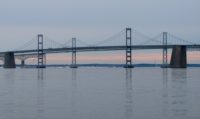 |
| Inspections of westbound span (right) found deteriorated concrete on deck's underside. (Photo courtesy of Maryland Transportation Authority) |
Inspections have found deteriorating concrete on the underside of the deck of one of the Chesapeake Bay Bridge's two parallel spans, Maryland Dept. of Transportation Secretary Robert L. Flanagan says. The department said on Dec. 22 that full-depth replacement of deck sections may be necessary. Flanagan said the bridge is safe for vehicles. "Our experts have confirmed that the closely spaced grid of steel rebar that makes up the backbone of the bridge is in good condition," he said.
The inspection was requested by a outside review panel that Flanagan established this fall to investigate another problem from a resurfacing project on the 4.3-mile-long westbound span. In the spring, inspectors saw widespread cracking in some sections of the bridge's deck. The department says the new, micro silica concrete overlay didn't bond properly to the substrata and delamination occurred. It says that analysis so far hasn't indicated any connection between the overlay problem and the deck underside's deterioration.
Officials will develop a plan to fix the deck underside concrete after electronic testing is done to see if the problem exists in other sections of the bridge. Regarding the cost of a repair plan, Jack Cahalan, a Maryland DOT spokesman, says, "Until they determine the scope of the deterioration and where it's located and develop a work plan, there is no way to develop a cost estimate as of yet." He says the results of the scan of the deck are expected in March.
|
Cahalan says that so far, the deterioration appears to be isolated to the sections toward the middle of the bridge, where the deck is 6.5 inches thick. Inspections also have been done on the underside of the 7-inch-thick decks nearer both shores, but to date have not seen deterioration in those sections, he adds.
The inspections, the most recent of which took place during the Dec. 17-19 weekend, involved cutting several six-foot-square sections of the steel form. Previous surface inspections didn't detect the problem. Cahalan declined to describe the nature of the concrete deterioration that had been found.
The Bay Bridge Overview Panel, chaired by former Transportation Research Board Executive Director Thomas B. Deen, is expected to issue its report on the overlay problem in January, Cahalan says.
The original $7-million resurfacing was part of a $76-million, two-phase redecking of the westbound span. The three-lane westbound span was opened to traffic in 1973. Its two-lane sibling span was built 20 years earlier.


Post a comment to this article
Report Abusive Comment